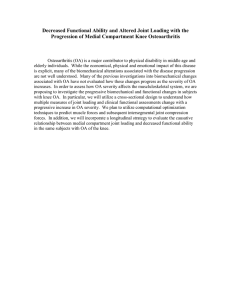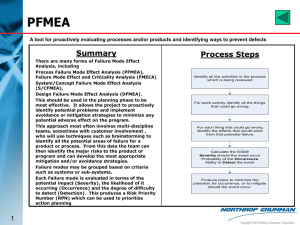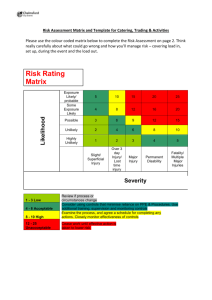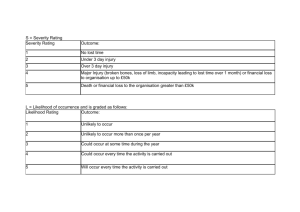Research Journal of Applied Sciences, Engineering and Technology 6(3): 468-476,... ISSN: 2040-7459; e-ISSN: 2040-7467
advertisement
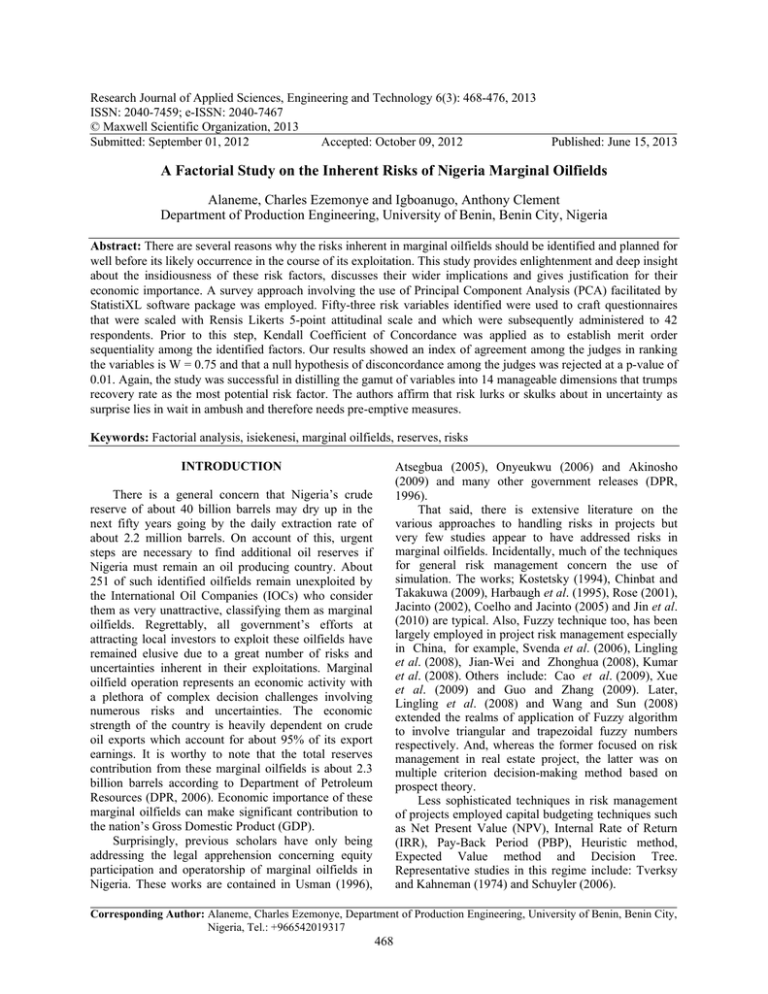
Research Journal of Applied Sciences, Engineering and Technology 6(3): 468-476, 2013 ISSN: 2040-7459; e-ISSN: 2040-7467 © Maxwell Scientific Organization, 2013 Submitted: September 01, 2012 Accepted: October 09, 2012 Published: June 15, 2013 A Factorial Study on the Inherent Risks of Nigeria Marginal Oilfields Alaneme, Charles Ezemonye and Igboanugo, Anthony Clement Department of Production Engineering, University of Benin, Benin City, Nigeria Abstract: There are several reasons why the risks inherent in marginal oilfields should be identified and planned for well before its likely occurrence in the course of its exploitation. This study provides enlightenment and deep insight about the insidiousness of these risk factors, discusses their wider implications and gives justification for their economic importance. A survey approach involving the use of Principal Component Analysis (PCA) facilitated by StatistiXL software package was employed. Fifty-three risk variables identified were used to craft questionnaires that were scaled with Rensis Likerts 5-point attitudinal scale and which were subsequently administered to 42 respondents. Prior to this step, Kendall Coefficient of Concordance was applied as to establish merit order sequentiality among the identified factors. Our results showed an index of agreement among the judges in ranking the variables is W = 0.75 and that a null hypothesis of disconcordance among the judges was rejected at a p-value of 0.01. Again, the study was successful in distilling the gamut of variables into 14 manageable dimensions that trumps recovery rate as the most potential risk factor. The authors affirm that risk lurks or skulks about in uncertainty as surprise lies in wait in ambush and therefore needs pre-emptive measures. Keywords: Factorial analysis, isiekenesi, marginal oilfields, reserves, risks INTRODUCTION Atsegbua (2005), Onyeukwu (2006) and Akinosho (2009) and many other government releases (DPR, 1996). That said, there is extensive literature on the various approaches to handling risks in projects but very few studies appear to have addressed risks in marginal oilfields. Incidentally, much of the techniques for general risk management concern the use of simulation. The works; Kostetsky (1994), Chinbat and Takakuwa (2009), Harbaugh et al. (1995), Rose (2001), Jacinto (2002), Coelho and Jacinto (2005) and Jin et al. (2010) are typical. Also, Fuzzy technique too, has been largely employed in project risk management especially in China, for example, Svenda et al. (2006), Lingling et al. (2008), Jian-Wei and Zhonghua (2008), Kumar et al. (2008). Others include: Cao et al. (2009), Xue et al. (2009) and Guo and Zhang (2009). Later, Lingling et al. (2008) and Wang and Sun (2008) extended the realms of application of Fuzzy algorithm to involve triangular and trapezoidal fuzzy numbers respectively. And, whereas the former focused on risk management in real estate project, the latter was on multiple criterion decision-making method based on prospect theory. Less sophisticated techniques in risk management of projects employed capital budgeting techniques such as Net Present Value (NPV), Internal Rate of Return (IRR), Pay-Back Period (PBP), Heuristic method, Expected Value method and Decision Tree. Representative studies in this regime include: Tverksy and Kahneman (1974) and Schuyler (2006). There is a general concern that Nigeria’s crude reserve of about 40 billion barrels may dry up in the next fifty years going by the daily extraction rate of about 2.2 million barrels. On account of this, urgent steps are necessary to find additional oil reserves if Nigeria must remain an oil producing country. About 251 of such identified oilfields remain unexploited by the International Oil Companies (IOCs) who consider them as very unattractive, classifying them as marginal oilfields. Regrettably, all government’s efforts at attracting local investors to exploit these oilfields have remained elusive due to a great number of risks and uncertainties inherent in their exploitations. Marginal oilfield operation represents an economic activity with a plethora of complex decision challenges involving numerous risks and uncertainties. The economic strength of the country is heavily dependent on crude oil exports which account for about 95% of its export earnings. It is worthy to note that the total reserves contribution from these marginal oilfields is about 2.3 billion barrels according to Department of Petroleum Resources (DPR, 2006). Economic importance of these marginal oilfields can make significant contribution to the nation’s Gross Domestic Product (GDP). Surprisingly, previous scholars have only being addressing the legal apprehension concerning equity participation and operatorship of marginal oilfields in Nigeria. These works are contained in Usman (1996), Corresponding Author: Alaneme, Charles Ezemonye, Department of Production Engineering, University of Benin, Benin City, Nigeria, Tel.: +966542019317 468 Res. J. Appl. Sci. Eng. Technol., 6(3): 468-476, 2013 Moreover, recently Petreska and KolemisevskaGugulovska (2010) employed probability theory to analyse risks inherent in projects. And, taken together, it is evident from the sample survey presented in the foregoing that a handful of approaches had been employed to analyze risks. The general approach in the literature so far appears to focus on aspects of risk managements in different workplace settings and the results also evidently differ just as the settings do. The present study seeks to identify a wide spectrum of variables that influence risks in marginal oilfields, classifying them in merit order using Kendall’s Coefficient of Concordance and then subjecting the variables to Factor Analysis so as to enable data summary and reduction into fewer dimensions to be achieved and thus facilitate the evolvement thereof of appropriate policy. It is therefore a systemic approach as against the approaches encountered in literature review. Thereafter, the scale items were used to develop a questionnaire bearing 53 questions that were administered to the 42 respondents. The crafting of the questionnaire was done with Rensis Liker’s 5-point attitudinal scale. The responses from the 42 respondents were collated to form a data matrix which forms the input to a Factor Analysis. A Statistic-XL® software package was used to analyze the data matrix. The output of the software gave the following; Descriptive Statistics, Communalities, Eigen Values, Un-rotated Factor Loadings, Rotated Factor Loadings, Scree Plot, Factor Plot and Case Wise Factor Scores. The screed plots showed that at Eigen value, 𝜆𝜆 = 1, the maximum factor extractable was 14. Moreover, visual inspection of the correlation coefficients showed that they had substantial values, suggesting that factor analysis is applicable. Further, the communalities yielded on the large part, meritorious values signifying the variables share common variance. The Kendall coefficient of concordance, (W) is given by: METHODOLOGY This study, which in all modesty, may be considered as a pilot exploratory survey, was undertaken at Nigeria Niger Delta between 2010 and 2012 using Isiekenesi Field, a partially appraised marginal oilfield as case study. Key variables (scale items) that have potential to evolve into risks in marginal oilfields exploitation were identified through a wide range of methods namely: Delphi technique, literature review, interviews, telephone calls, group discussions and so forth. The merit order of these variables was statistically determined by the use of Kendall Coefficient of Concordance (W) that required 42 Judges to provide an ordinal scale ranking of the items. The Judges were drawn from a homogenous set of professionals and practicing managers in the oil and gas industry. Table 1: Risk variables S/N Risk variable 1 Paucity of geological data 2 Oilfield size 3 Dry hole 4 Bottom-hole-location 5 Reservoir connectivity 6 Reservoir damage 7 Formation stock tank 8 Marginality of reserves 9 Recovery rates 10 Gross rock volume 11 Crude properties 12 Formation water, Basic Sediment and Water (BS&W) 13 Statistical prediction risk 14 Reservoir modeling 15 Reservoir natural drive limit 16 Well control 17 Artificial recovery 18 Well impairment W = S 1 k2 12 (n 3 −n ) (1) It is a measure of the extent agreement to which the judges ranked the variables among themselves: χ2 = K (N-1) W (2) Sure enough, χ2 provides the significance level at which the coefficient of concordance (W) was adjudged as acceptable or otherwise. And, last, Table 1 depicts the compilation of the identified risk variables. S/N 19 20 21 22 23 24 25 26 27 28 29 30 Risk variable Geographical location Oilfield remoteness Processing facilities closeness Processing facilities inadequacy Technology limitations Project management risks Loss of containment Operational risk Operating cost of marginal oilfields Manpower resource availability Logistics Gambler’s ruin S/N 37 38 39 40 41 42 43 44 45 46 47 48 Risk variable Interest rates Exchange rates Market demands Regulations Resources cost volatility Royalties and tax regime Nationalization Production quota restriction Partners’ un-supportiveness Obstructiveness of IOCs Legal risks Security of property and personnel 31 32 33 34 35 36 Spot market price Financial and economic constraint Development capital and lifting cost Collaboration alliance Funding/financial risk Oil market volatility 49 50 51 52 53 Safety risk Population encroachment to Facilities Host community restiveness Environmental impact Political instability 469 Res. J. Appl. Sci. Eng. Technol., 6(3): 468-476, 2013 RESULTS AND DISCUSSION judges were consistent in their ranking of the 53 variables. Further, our study data provided paucity of evidence for us to accept a null hypothesis of lack of discordance of ranking among selected judges. In other words, the null hypothesis was rejected at a p-value of 0.01. Results of this study are presented in the following sequence: Coefficient of concordance: The computed value for coefficient of concordance (W) is 0.71 and the associated chi-squared value (χ2) is 546 which are greater than 27.69 recorded in the statistics table at significance level of 0.01. The implication is that 42 Table 2: Descriptive statistics Variables Mean 1 3.261900 2 4.214290 3 3.333330 4 3.142860 5 3.166670 6 3.071430 7 3 8 3.285710 9 4.142860 10 2.952380 11 3.238100 12 3.142860 13 2.952380 14 3.142860 15 3.904760 16 2.952380 17 2.952380 18 3.095240 19 4.190476 20 4.166667 21 4.309524 22 2.976190 23 2.857143 24 4.071429 25 3.023810 26 3.023810 27 4.380952 28 4 29 3.214286 30 3.095238 31 2.880952 32 4.285714 33 4.071429 34 3.119048 35 4.333333 36 3.214286 37 3.166667 38 3.095238 39 1.785714 40 3.404762 41 3.261905 42 3.357143 43 3 44 3 45 2.976190 46 2.952381 47 3.047619 48 4.452381 49 3.261905 50 3.166667 51 4.071429 52 3.142857 53 3.119048 Factor analysis: Table 2 shows the descriptive statistics that gives a summary of the respondents’ S.D. 0.627010 0.812580 0.721340 0.521320 0.580860 0.639850 0.987730 0.891310 1.001740 0.763570 0.957880 0.899090 0.854040 0.683300 1.393530 0.622830 0.696770 0.617210 1.173656 1.145866 0.975007 0.949662 0.871540 1.217612 0.896826 0.780497 0.909365 1.229713 0.842057 0.849950 0.832346 0.891305 1.197413 0.861150 1.004057 0.519649 0.762431 0.849950 1.048477 0.828149 0.627015 0.692166 0.698430 0.493865 0.562577 0.622833 0.538851 0.832346 0.543679 0.537232 0.558432 0.417392 0.632547 S.E. 0.096800 0.125400 0.111300 0.080400 0.089600 0.098700 0.152400 0.137500 0.154600 0.117800 0.147800 0.138700 0.131800 0.105400 0.215000 0.096100 0.107500 0.095200 0.181099 0.176811 0.150447 0.146536 0.134482 0.187882 0.138383 0.120433 0.140318 0.189749 0.129932 0.131150 0.128434 0.137531 0.184765 0.132878 0.154929 0.080184 0.117646 0.131150 0.161783 0.127786 0.096750 0.106804 0.107770 0.076205 0.086807 0.096105 0.083146 0.128434 0.083891 0.082897 0.086168 0.064405 0.097604 470 N 42 42 42 42 42 42 42 42 42 42 42 42 42 42 42 42 42 42 42 42 42 42 42 42 42 42 42 42 42 42 42 42 42 42 42 42 42 42 42 42 42 42 42 42 42 42 42 42 42 42 42 42 42 Community 0.806203146 0.838712930 0.860845360 0.918698420 0.890049410 0.970031800 0.796362630 0.924845220 0.942947430 0.947297770 0.872134140 0.963475250 0.854651720 0.933642820 0.819871240 0.923823590 0.910881270 0.955671600 0.949762791 0.894487895 0.922895665 0.934825921 0.921160858 0.918748770 0.850559228 0.938543991 0.969950018 0.942133265 0.860015315 0.914385042 0.908813029 0.958833061 0.962330888 0.855259145 0.911456855 0.971466881 0.918427039 0.960530495 0.895558580 0.942848712 0.937356287 0.743048170 0.906340795 0.813270352 0.868412084 0.927396899 0.852085231 0.899901991 0.883083561 0.917773693 0.918544034 0.909490747 0.899823956 Res. J. Appl. Sci. Eng. Technol., 6(3): 468-476, 2013 factors extracted. Moreover, the scree plot shows that at Eigen value of λ = 1, 14 factors emerged. The significance of these results is that the PCA software applied was successful in achieving substantial parsimony in terms of data reduction and summarization. The un-rotated factor loadings obtained failed to achieve uniqueness in terms of belongingness of each variable to a specific factor. Accordingly, varimax rotation became expedient; a process that now achieved the uniqueness thereof in the process of extracting 14 factors. It is significant to note that variables that failed to wield factor loading of close to ±0.5 were discarded. Figure 1 shows the scree plot that follows, while Fig. 2 depicts the factor plot. Fig. 1: Scree plot Creative labeling of the fourteen factors: The PCA model employed was successful in drastically reducing the 53 variables to mere 14 dimensions or factors, a parsimony that can enhance policy development. The first factor (F 1 ) shown in Table 3, creatively labeled kernel of risk concentration, embodies 13 variables, all wielding positive factor loadings. As can be noticed from the platoon, top on the list is Recovery Rate, wielding a meritorious loading of 0.879 and the least in the group, in merit order, is Security of Property and Personnel, having middling factor loading of 0.563. Remarkably, each variable, except the last, has either meritorious or substantial factor loadings. Considering the variables with serial numbers 1 to 7, the loadings are meritorious being higher than 0.800. The others, except the last, have substantial factor loadings on account of their magnitude being around 0.700. It may be significant to emphasize that the magnitude of factor loadings portrays the relative importance the variables play in the platoon. Further, the likelihood of occurrence stated in percentage gives an indication of the probability of the events described by the variables happening. Generally, there is more than 80% chance of the events occurring. And, again, the severity index vector is an Fig. 2: Factor plot scores and communalities of the variables. The serial numbering of the 53 variables in Table 2 is consistent with the listing of Table 1. It is evident from the Table 2 that a large part of the values are meritorious, suggesting therefore that the variables account for significant variance among the Table 3: Kernel of risk concentration (F 1 ) S/N Variable no. Variable description 1 9 Recovery rate 2 32 Financial and economic constraint 3 33 Development capital and lifting cost 4 28 Manpower resource availability 5 27 Operating cost of marginal oilfields 6 15 Reservoir natural drive limit 7 24 Project management risk 8 2 Oilfield size 9 20 Oilfield remoteness 10 35 Funding/financial risk 11 21 Processing facilities closeness 12 19 Geographical location 13 48 Security of property & personnel Factor loading 0.879 0.877 0.866 0.837 0.812 0.806 0.806 0.789 0.781 0.731 0.722 0.710 0.563 471 Mean likelihood of occurrence (%) 82 86 82 80 88 78 82 84 84 86 86 84 90 Mean severity index 3.2 3.0 3.4 2.0 3.5 2.5 2.9 2.2 2.9 3.1 2.3 2.8 4.5 Res. J. Appl. Sci. Eng. Technol., 6(3): 468-476, 2013 Table 4: Socioeconomic and techno-political risks (F 2 ) S/N 1 2 3 4 5 6 7 8 9 Variable no. 25 47 43 50 38 26 12 51 37 Variable description Loss of containment Legal risk Nationalization Population encroachment to facilities Exchange rates Operational risk Formation water, basic sediment and water (BS&W) Host community restiveness Interest rates Factor loading 0.860 0.837 0.715 0.702 0.596 0.569 0.560 0.558 0.479 Mean likelihood of occurrence (%) 60 60 60 64 62 60 62 82 64 Mean severity index 3.0 3.0 3.8 2.1 2.1 2.3 1.7 3.9 2.3 Table 5: Reservoir uncertainty risks (F 3 ) S/N 1 2 Variable no. 5 8 Variable description Reservoir connectivity Marginality of reserves Factor loading 0.780 0.780 Mean likelihood of occurrence (%) 64 66 Mean severity index 2.2 2.4 Variable description Formation stock tank Bottom-hole-location Factor loading 0.804 0.604 Mean likelihood of occurrence (%) 60 62 Mean severity index 3.9 2.6 Table 6: Reservoir voluminosity (F 4 ) S/N 1 2 Variable no. 7 4 indication of the severity level of the variables described. For example, although the last variable to wit: Security of Property and Personnel is rated least on account of magnitude of factor loading, the chances of having insecurity is seriously rated ninety percent (90%) and when such things happen, the situation will be critical, that is 4.5 severity index. In reality, the ranking of security issue, judging by factor loading, is factual in the sense that security of properties and personnel is ancillary to the socio-technical system. The core variables incidental to production are listed in serial numbers 1 to 12. Ironically, the last item, Security of Property and Personnel has the highest probability of occurrence and happens to be very serious. And, this now takes us to the next cluster labeled socio-economic and techno-political risks (F 2 ) in Table 4. Factor 2 is another sturdy or stocky factor on account of its positive factor loadings. Nine of the variables are clustered therein. The most important of them is Loss of Containment bearing a factor loading of 0.860. This is a serious threat to production as it can take the following forms: well blowout, well kick, pipeline rupture and explosion, process upset, third party damage and similar occurrences. Another critical variable next to loss of containment is Legal Risk which has the potential to stall operation and could take the nature of land disputes, right of way acquisition and regulatory non-compliance. It may also be pointed out that although item number 8, Host Community Restiveness has a comparatively low factor loading of 0.558, it is of less significance in the group, but its probability of occurrence is very high being eighty-two percent (82%) and incidentally the severity index is rated as being serious, that is 3.9. That said, the next factor (F 3 ) in Table 5, is captioned reservoir uncertainty risks. The two variables loaded under the third factor F 3 are both substantial having the same factor loading of 0.780. The first variable called Reservoir Connectivity is usually preceded by exploratory wells and considered very vital in reservoir management. The importance is to optimize the number of wells required to economically develop an oilfield. The second variable called Marginality of Reserves affect the total recoverable hydrocarbon. And, the smaller the voluminocity of each reserve, the more challenging it becomes in the exploitation. The associated probabilities and severity indices are considered significant. Again, we move to Table 6 with the next cluster F 4 called reservoir voluminosity. It is a bi-polar factor containing Formation Stock Tank, that is, Stock Tank of Oil Initially in Place (STOIIP), having a meritorious factor loading of 0.804. This is a reflection of the total volume of oil that is stored or trapped in the reservoir. Bottom-HoleLocation on the other hand, signifies the depth of the reservoir. It wields a fairly substantial loading of 0.604. Both variables have fairly equal likelihood of occurrence (60 and 62%) in that order. Also, the severity indices are near critical and moderate respectively. The implication of this factor is that, should the forecast of these variables be wide from 472 Res. J. Appl. Sci. Eng. Technol., 6(3): 468-476, 2013 Table 7: Barriers (F 5 ) S/N 1 2 3 4 Variable no. 23 6 46 22 Factor loading 0.881 0.831 0.659 0.473 Mean likelihood of occurrence (%) 58 62 60 60 Mean severity index 2.2 2.9 2.0 2.7 Variable description Gambler’s ruin Logistics Factor loading 0.802 0.672 Mean likelihood of occurrence (%) 62 64 Mean severity index 2.6 2.4 Variable description Partner’s unsupportiveness Oil market volatility Factor loading 0.789 0.506 Mean likelihood of occurrence (%) 64 60 Mean severity index 3.0 2.0 Variable description Spot market price Safety risk Factor loading 0.764 0.725 Mean likelihood of occurrence (%) 58 66 Mean severity index 2.4 2.2 Variable description Technology limitations Reservoir damage Obstructiveness of IOCs Processing facilities inadequacy Table 8: Operational and chancified risks (F 6 ) S/N 1 2 Variable no. 30 29 Table 9: Ebb and flow risks (F 7 ) S/N 1 2 Variable no. 36 45 Table 10: Security and returns risks (F 8 ) S/N 1 2 Variable no. 31 49 expectation, the yield may be disappointingly low. Next is factor 5 (F 5 ) in Table 7 called barriers. Four variables are clustered here also showing limiting effect. The first two, Technology Limitation and Reservoir Damage, both wield 0.881 and 0.831 respectively. Evidently, technology limitation defines hindrance having to wit: dearth of technology and equipment needed for exploration while reservoir damage could be caused by myriad of situations mainly during drilling activities. On the other hand, lack of supportiveness from international oil companies expectedly may create barriers in crude handling and processing such as placing restrictions in the utilization of existing pipelines, flow stations and export terminals may discourage new venture capitalists. Also, Processing Facilities Inadequacy could be another area of risk requiring huge investment. Though it is rated low with a factor loading of 0.473, but its probability of occurring is near high level. In addition, processing Facilities Inadequacy has second highest severity index of near moderate value of 2.7. Following next is operational and chancified risks, F 6 in Table 8. This is another dual factor huddle consisting of Gambler’s Ruin with meritorious factor loading of 0.802 and Logistics having a factor loading of 0.672. Both of them have near high probabilities of occurrence exceeding 60% and moderate severity index of 2.6. Gambler’s Ruin projects an image of possible loss of investment and 60% of the time it happens and when it happens it is always severe. On the other hand, Logistics require huge investment in organizational planning, personnel, equipment and product transportation. This escorts us to the next platoon in Table 9 called ebb and flow risks consisting of partner’s un-supportiveness and oil market volatility with moderate factor loading of 0.789 and middling loading of 0.506, respectively. Partners’ supportiveness is available at the whims of the foreign partner which could be withdrawn at anytime depending on the prevailing economic fortunes of the business. On the other hand, Oil Market Volatility, like cyclical activities, manifests in cadence. It is driven by the global market forces and policy. The probabilities of their occurrence are above 60% in each case and their severity indices are 3.0 (moderate) and 2.0 (near low). Further in Table 10, we take the next factor F 8 called security and returns risks. Both variables show a factor loading of 0.764 and 0.725, likelihood of occurrence of 58 and 66% and severity index of 2.4 and 2.5, respectively. Admittedly, the stock market price, like oil market volatility in the immediate preceding factor, show variability that has attendant high risk. The reason is that the stock market price could fall well below projected revenues values and vice versa which could have serious economic effect. On the other hand, Safety Risk could be a sort of disruptive legal tangle. Another factor is yield and operations risk, F 9 As compiled in Table 11. The first three variables share substantial factor loading all exceeding 0.7 while the last has above 473 Res. J. Appl. Sci. Eng. Technol., 6(3): 468-476, 2013 Table 11: Yield and operations risks (F 9 ) S/N 1 2 3 4 Variable no. 34 18 10 39 Factor loading 0.785 0.732 0.729 0.660 Mean likelihood of occurrence (%) 62 62 60 36 Mean severity index 2.5 2.7 2.2 1.4 Variable description Statistical prediction risk Crude properties Well control Reservoir modeling and management Factor loading 0.852 0.689 0.577 0.566 Mean likelihood of occurrence (%) 60 64 60 62 Mean severity index 2.2 1.4 2.4 2.3 Variable description Dry hole Paucity of geological data Factor loading 0.810 0.457 Mean likelihood of occurrence (%) 66 66 Mean severity index 3.0 3.1 Variable description Artificial production recovery Resources cost volatility Factor loading 0.924 0.525 Mean likelihood of occurrence (%) 60 66 Mean severity index 2.8 3.0 Variable description Collaborative alliance Well impairment Gross rock volume Market demands Table 12: Well production management (F 10 ) S/N 1 2 3 4 Variable no. 13 11 16 14 Table 13: Wildcat risk syndrome (F 11 ) S/N 1 2 Variable no. 3 1 Table 14: Ancillary costs risk (F 12 ) S/N 1 2 Variable no. 17 41 middling factor loading 0.66. In the merit order, Collaborative Alliance may involve sharing of information and technical know-how amongst oilfield operators. Well Impairment may be caused by operational activities such as well re-entry, acidization and water injection. Also, Gross Rock Volume denotes the percentile of oil bearing regions of the reservoirs and when wrongly estimated could affect the overall field economics. Market Demand connotes the uncertainty or fear of restricted demand for the national crude. Their likelihood of occurrence and severity index are indicated. The next factor, F 10 in Table 12 is a quadri-variable called well production management. Topping the list is Statistical Prediction Risk with meritorious factor loading of 0.852. Technically, it represents risks that can spring out from errors in the estimation of well parameters. Crude Oil Properties on the one hand, wielding a near substantial factor loading of 0.689, may refer to issues like quality of the hydrocarbon deposit such as the API gravity, viscosity and sweetness of the crude. Another important variable in the well production management is Well Control, having a middling factor loading of 0.577. This dictates the rate of withdrawal which has significant impact on the amount of BS&W that comes with the production and has potential to increase investment in facilities costs. Last, Reservoir Modeling and Management involve virtual recreation of the reservoir description. It needs to be properly managed in order to forestall delays in oil wells development activities and payback period. Again, we move to Table 13, the next platoon (F 11 ) called wildcat risk syndrome. This expounds the effect of insufficient information about the geological morphology that could lead to erroneously drilling oil wells at the wrong place, or not hitting oil at a commercial quantity, which is a hit-and-miss syndrome. The next is ancillary costs risk in Table 14. The first and with the highest ever factor loading of 0.924 is called Artificial or Secondary Production Recovery. This requires artificial or secondary intervention to boost reservoir pressure at the decline of natural drive. It comes in the form of reservoir enhancement either through water injection, gas injection, gas lift and acidization, the deployment of mechanical machinery such as Electrical Submersible Pumps (ESPs) or their combination. Remarkably, this variable is the most crucial being very common with marginal oilfields. Its probability of occurrence is 60% and the severity index is near moderate. On the other hand, Resources Cost Volatility is a miscellaneous variable involving technical manpower equipment, technology and materials. Another important factor is bio-political risk (F 13 ), a dual factor loading contained in Table 15. It is well known that there is certain to be more biology politics which could mean more politics in 474 Res. J. Appl. Sci. Eng. Technol., 6(3): 468-476, 2013 Table 15: Bio-political risks (F 13 ) S/N 1 2 Variable no. 53 52 Variable description Political instability Environmental impact Factor loading 0.791 0.624 Mean likelihood of occurrence (%) 62 62 Mean severity index 3.9 3.8 Factor loading 0.782 Mean likelihood of occurrence (%) 68 Mean severity index 4.5 Table 16: Compliance risk (F 14 ) S/N 1 Variable no. 40 Variable description Regulations • biology. It is a useful piece of shorthand to suggest political efforts to reconcile biological facts and environmental degradation. Both variables are dialectical and carry with them attendant risks. Both, too, have equal probability of occurrence (62%) and near equal severity index about 3.8. And, this takes us to Table 16; the last lone cluster (F 14 ) christened compliance risk. It has a substantial loading of 0.782, high percentage of likelihood of occurrence (68%) and among the highest severity index of 4.5. This variable, Regulations, has to do with regulatory laws and procedures guiding oil and gas operations. In finality, we have analyzed fourteen categories of risk clusters that are peculiar with operating marginal oilfields in Nigeria. The implications of the foregoing analysis are numerous to wit: • • • • • • REFERENCES Akinosho, T., 2009. Nigeria Marginal Field Review: Bid Round Africa, Oil + Gas Report. December Edn., Nigeria Department of Petroleum Resources, Nigeria. Atsegbua, L., 2005. Issues in the development of marginal oilfields in Nigeria. J. Energ. Nat. Resou. L. 23(3): 323-336. Cao, Q., J. Ruan and K. Liu, 2009. Fuzzy evaluation on mining investment decision based on membership degree. Transformation new algorithm M (1, 2, 3), 2009. ISECS International Colloquium on Computing, Communication, Control and Management, 978-1-4244-4246-1/09/$25.00 ©2009 IEEE CCCM 2009. Chinbat, U. and S. Takakuwa, 2009. Using Simulation analysis for mining risk management project. Proceedings of the 2009 Winter Simulation Conference (WSC), Nagoya, Japan, pp: 2612-2623. Coelho, D.K. and C.M.C. Jacinto, 2005. Risk assessment of drilling and completion operations in petroleum wells using a Monte Carlo and a neural network approach. Proceedings of the 2005 Winter Simulation Conference, Institute of Electrical and Electronics Engineers, pp: 1892-1897. DPR (Department of Petroleum Resources), 1996. Draught Guidelines for Farm-out and Operation of Marginal Fields. Nigeria. DPR (Department of Petroleum Resources), 2006. Annual Report. Lagos, Nigeria. It brings to bear the militating factors that would affect operations and profitability of marginal oilfields in Nigeria. It will help an operator and the government to visualize the extent of risk that is embedded in marginal oilfields. It serves as a working tool for any investor who wants to engage in marginal or any oilfield operation in Nigeria with a lateral worldwide application. CONCLUSION The overall result of this study has clarified issues relating to risk profile in the marginal oilfield. It is well known that risk lurks or skulks in uncertainty as surprise lies in wait in ambush. However, some areas of ambiguity or unresolved puzzling questions that come to mind are as follows: • To what extent do the local operators and venture capitalists equipped and capable to meet the challenges posed in these findings? To what extent are the venture capitalists ready and willing to collaborate with each other in the sharing of information and technical/ operational experience? To what extent are the independent oil companies willing and ready to play along in providing necessary operational and technical supports as may be needed? How are the venture capitalists ready to optimize their relationship with foreign partners to secure the much needed technical and financial supports? How is the government willing and ready to regulate and guide the operations of marginal oilfields in Nigeria without adding unnecessary regulatory burdens? 475 Res. J. Appl. Sci. Eng. Technol., 6(3): 468-476, 2013 Guo, Z. and Q. Zhang, 2009. A new approach to project risk evaluation based on intuitionist fuzzy sets. International Conference on Fuzzy Systems and knowledge Discovery Proceedings, 6: 58-61. Harbaugh, J.W., J.C. Davis and C. Wendebourg, 1995. Computing risk for oil prospects: Principles and programs. Computer Methods in the Sciences, Vol. 4, ISBN-10: 0080418902, Har/Dsk Edn., Pergamon Publishers. Jacinto, C.M.E., 2002. Optimal investment decisions for a set of projects under conditions of uncertainty. Discrete Event Simulation for the Risk of Development of an Oilfield Proceedings of the Water Simulation Conference. Jian-Wei, L.V. and L. Zhonghua, 2008. Research on dynamic evolvement analysis and modeling of risk in development of navy vessel. 4th International Conference on Wireless Communications, Networking and Mobile Computing, WiCOM '08, Wuhan, pp: 1-4. Jin, D., Z. Wang, X. Liu, J.M. Yang and M. Han, 2010. Construction project schedule risk analysis and assessment using Monte Carlo simulation method. IEEE International Conference on Advanced Management Science (ICAMS), Nanjing, China, 1: 597-601. Kostetsky, O., 1994. A facilitated, graphics and Monte Carlo based predicted project process. Engineering Management Conference Proceedings, IEEE International Conference, pp: 177-184, ISBN: 07803-1955-9, CH3458-7194/0006, Indexed by IET Inspec. Kumar, M., D. Arndt, S. Kreuzfeld, T. Kerstin, N. Stoll and R. Stoll, 2008. Fuzzy techniques for subjective workload-score modeling under uncertainties. IEEE T. Syst. Man Cy. B, 38(6), ISBN: 10834419/$25.00 © 2008 IEEE. Lingling, M., C. Liwen and L. Ping, 2008. Real Estate Investment Risk Analysis Based on Fuzzy AHP. ISBN: 978-1-4244-2108-4/08/$25.00 © 2008 IEEE. Onyeukwu, H., 2006. Securitization of Foreign Investments in Marginal Oilfields. Oil & Gas Economic Policy & Business Strategy Venture. Petreska, B.R. and T.D. Kolemisevska-Gugulovska, 2010. A fuzzy rate-of-return based model for portfolio selection and risk estimation. IEEE International Conference on Systems Man and Cybernetics (SMC), Digital Object Identifier: 10.1109/ICSMC.2010.5642278, pp: 1871-1877. Rose, P., 2001. Risk Analysis and Management of Petroleum Exploration Ventures. AAPG Methods in Exploration Series, No. 12, AAPG, USA. Schuyler, J., 2006. Project Investment Decision Analysis. Petroskills, Tulsa, United States. Svenda, G.S., S. Kanjuh, T. Konjic and V. Miranda, 2006. Using a Fuzzy Modeling in Decision Making for Planning Under Uncertainty with Risk Analysis Paradigm, IEEE Publication. 8th Seminar on Neutral Network Application in Electrical Energy, Nev Rel. Retrieved from: http:// www. ewh. ieee. org/reg/8/conferences.html, September. Tverksy, A. and D. Kahneman, 1974. Judgment under uncertainty: Heuristics and biases. Science, 185: 1124-1131. Usman, A., 1996. Recent Developments in the Oil and Gas Industry. Retrieved from: http:// www.foakinrele.com/pdfs/oil&gas/recentdevelopm ents.pdf. Wang, J.Q. and T. Sun, 2008. Fuzzy multiple criteria decision making method based on prospect theory. International Conference on Information Management, Innovation Management and Industrial Engineering, ISBN: 978-0-7695-34350/08 $25.00 © 2008 IEEE, DOI 10.1109/ICIII.2008.229. Xue, Y., C. Huang and X.W. Huang, 2009. A new method and its application of handling fuzzy uncertainty of data in disaster risk assessment. Global Congress on Intelligent Systems, ISBN: 978-0-7695-3571-5/09 $25.00 © 2009 IEEE, DOI 10.1109/GCIS.2009.221. 476
